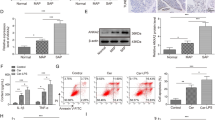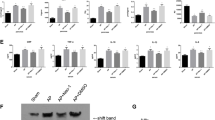Abstract
Background: Resistin, an adipocytokine secreted by fat tissues, has been associated with the inflammatory response, though its role in inflammation during acute pancreatitis (AP) remains unclear. Objective: The proinflammatory response following acinar cell injury impacts pancreatitis severity, necessitating better understanding of functional consequences associated with pancreatic acinar cell resistin exposure and resultant effects on proinflammatory signaling. Methods: Amylase-secreting rat pancreatic acinar AR42J cells were subjected to 1, 10, or 100 ng/ml recombinant rat resistin treatments. Cytotoxicity was evaluated by amylase secretion and lactate dehydrogenase (LDH) release. Tumor necrosis factor-alpha (TNF-α) and interleukin 6 (IL-6) mRNA and protein expressions were determined by real-time real time-PCR and enzyme-linked immunosorbent assay, respectively. Nuclear NF-κB p65 subunit protein level was measured by western blotting. Results: Significantly increased amylase secretion and LDH release was observed in the 100 ng/ml resistin treatment (p<0.01). Both TNF-α and IL-6 protein expression levels increased in a concentration-dependent manner when treated with resistin. Pretreatment of resistin-treated AR42J cells with the NF-κB inhibitor PDTC, which decreases the NF-κB p65 subunit protein expression levels in the nuclei, produced significantly lower mRNA expression levels for both TNF-α and IL-6 compared with those produced by resistin-treated cells (p<0.01). Conclusions: Resistin exhibits some cytotoxic activity in rat pancreatic acinar AR42J cells and stimulates proinflammatory cytokine TNF-α and IL-6 production via NF-κB activation. Thus, overproduction of obesity-related circulating resistin and associated low-grade inflammation may result in mild injury to pancreatic acini, increasing AP severity and risk.
Similar content being viewed by others
References
Muddana V, Evans AC, Langmead CJ, et al. 475o resistin, a potent adipokine, is associated with acute pancreatitis: assessment of functional genetic polymorphisms and serum levels. Gastroenterology 2010, 138: S–66.
Karmiris K, Koutroubakis IE, Kouroumalis EA. Leptin, adiponectin, resistin, and ghrelin — implications for inflammatory bowel disease. Mol Nutr Food Res 2008, 52: 855–66.
Schaffler A, Ehling A, Neumann E, et al. Adipocytokines in synovial fluid. JAMA 2003, 290: 1709–10.
Bokarewa M, Nagaev I, Dahlberg L, Smith U, Tarkowski A. Resistin, an adipokine with potent proinflammatory properties. J Immunol 2005, 174: 5789–95.
Steppan CM, Bailey ST, Bhat S, et al. The hormone resistin links obesity to diabetes. Nature 2001, 409: 307–12.
Daniel P, Lesniowski B, Jasinska A, Pietruczuk M, Malecka-Panas E. Usefulness of assessing circulating levels of resistin, ghrelin, and IL-18 in alcoholic acute pancreatitis. Dig Dis Sci 2010, 55: 2982–7.
Rabe K, Lehrke M, Parhofer KG, Broedl UC. Adipokines and insulin resistance. Mol Med 2008, 14: 741.
Karmiris K, Koutroubakis IE, Xidakis C, Polychronaki M, Voudouri T, Kouroumalis EA. Circulating levels of leptin, adiponectin, resistin, and ghrelin in inflammatory bowel disease. Inflamm Bowel Dis 2006, 12: 100–5.
Abu Hilal M, Armstrong T. The impact of obesity on the course and outcome of acute pancreatitis. Obes Surg 2008, 18: 326–8.
Johnson CD, Toh SK, Campbell MJ. Combination of APACHE-II score and an obesity score (APACHE-O) for the prediction of severe acute pancreatitis. Pancreatology 2004, 4: 1–6.
Martinez J, Johnson CD, Sanchez-Paya J, de Madaria E, Robles-Diaz G, Perez-Mateo M. Obesity is a definitive risk factor of severity and mortality in acute pancreatitis: an updated meta-analysis. Pancreatology 2006, 6: 206–9.
Shetty GK, Economides PA, Horton ES, Mantzoros CS, Veves A. Circulating adiponectin and resistin levels in relation to metabolic factors, inflammatory markers, and vascular reactivity in diabetic patients and subjects at risk for diabetes. Diabetes Care 2004, 27: 2450–7.
Al-Daghri N, Chetty R, McTernan PG, et al. Serum resistin is associated with C-reactive protein & LDL cholesterol in type 2 diabetes and coronary artery disease in a Saudi population. Cardiovasc Diabetol 2005, 4: 10.
Silswal N, Singh AK, Aruna B, Mukhopadhyay S, Ghosh S, Ehtesham NZ. Human resistin stimulates the pro-inflammatory cytokinesTNF-alpha and IL-12 in macrophages by NF-kappaB-dependent pathway. Biochem Biophys Res Comm 2005, 334: 1092–101.
Dios ID. Inflammatory role of the acinar cells during acute pancreatitis. World J Gastrointest Pharmacol Ther 2010, 1: 15–20.
Blinman TA, Gukovsky I, Mouria M, et al. Activation of pancreatic acinar cells on isolation from tissue: cytokine upregulation via p38 MAP kinase. Am J Physiol Cell Physiol 2000, 279: C1993–2003.
Ramudo L, Manso MA, De Dios I. Biliary pancreatitis-associated ascitic fluid activates the production of tumor necrosis factor-alpha in acinar cells. Crit Care Med 2005, 33: 143–8 (discussion 248).
Pereda J, Sabater L, Cassinello N, et al. Effect of simultaneous inhibition of TNF-alpha production and xanthine oxidase in experimental acute pancreatitis: the role of mitogen activated protein kinases. Ann Surg 2004, 240: 108–16.
Barnes PJ, Karin M. Nuclear factor-kappaB: a pivotal transcription factor in chronic inflammatory diseases. N Engl J Med 1997, 336: 1066–71.
Wulczyn FG, Krappmann D, Scheidereit C. The NF-kappa B/Rel and I kappa B gene families: mediators of immune response and inflammation. J Mol Med (Berl) 1996, 74: 749–69.
Hofken T, Keller N, Fleischer F, Goke B, Wagner AC. Map kinase phosphatases (MKP’s) are early responsive genes during induction of cerulein hyperstimulation pancreatitis. Biochem Biophys Res Commun 2000, 276: 680–5.
Lerch MM, Saluja AK, Dawra R, Ramarao P, Saluja M, Steer ML. Acute necrotizing pancreatitis in the opossum: earliest morphological changes involve acinar cells. Gastroenterology 1992, 103: 205–13.
Scholmerich J. Interleukins in acute pancreatitis. Scand J Gastroenterol Suppl 1996, 219: 37–42.
Gukovskaya AS, Gukovsky I, Zaninovic V, et al. Pancreatic acinar cells produce, release, and respond to tumor necrosis factor-alpha. Role in regulating cell death and pancreatitis. J Clin Invest 1997, 100: 1853–62.
Kim H, Seo JY, Roh KH, Lim JW, Kim KH. Suppression of NF-kappaB activation and cytokine production by N-acetylcysteine in pancreatic acinar cells. Free Rad Biol Med 2000, 29: 674–83.
Perides G, Weiss ER, Michael ES, Laukkarinen JM, Duffield JS, Steer ML. TNF-alpha-dependent regulation of acute pancreatitis severity by Ly-6C(hi) monocytes in mice. J Biol Chem 2011, 286: 13327–35.
Moors MA, Mizel SB. Proteasome-mediated regulation of interleukin-1 beta turnover and export in human monocytes. J Leukocyte Biol 2000, 68: 131–6.
Livak KJ, Schmittgen TD. Analysis of relative gene expression data using real-time quantitative PCR and the 2(-Delta Delta C(T)) Method. Methods 2001, 25: 402–8.
Sunden-Cullberg J, Nystrom T, Lee ML, et al. Pronounced elevation of resistin correlates with severity of disease in severe sepsis and septic shock. Crit Care Med 2007, 35: 1536–42.
Fain JN, Madan AK, Hiler ML, Cheema P, Bahouth SW. Comparison of the release of adipokines by adipose tissue, adipose tissue matrix, and adipocytes from visceral and subcutaneous abdominal adipose tissues of obese humans. Endocrinology 2004, 145: 2273–82.
Papachristou GI, Papachristou DJ, Avula H, Slivka A, Whitcomb DC. Obesity increases the severity of acute pancreatitis: performance of APACHE-O score and correlation with the inflammatory response. Pancreatology 2006, 6: 279–85.
Schaffler A, Hamer O, Dickopf J, et al. Admission resistin levels predict peripancreatic necrosis and clinical severity in acute pancreatitis. Am J Gastroenterol 2010, 105: 2474–84.
Steppan CM, Bailey ST, Bhat S, et al. The hormone resistin links obesity to diabetes. Nature 2001, 409: 307–12.
Rangwala SM, Rich AS, Rhoades B, et al. Abnormal glucose homeostasis due to chronic hyperresistinemia. Diabetes 2004, 53: 1937–41.
Rajala MW, Qi Y, Patel HR, et al. Regulation of resistin expression and circulating levels in obesity, diabetes, and fasting. Diabetes 2004, 53: 1671–9.
Qatanani M, Szwergold NR, Greaves DR, Ahima RS, Lazar MA. Macrophage-derived human resistin exacerbates adipose tissue inflammation and insulin resistance in mice. J Clin Invest 2009; 119: 531–9.
Lehrke M, Reilly MP, Millington SC, Iqbal N, Rader DJ, Lazar MA. An inflammatory cascade leading to hyperresistinemia in humans. PLoS Med 2004, 1: e45.
Pang SS, Le YY. Role of resistin in inflammation and inflammation-related diseases. Cell Mol Immunol 2006, 3: 29–34.
Adeghate E. An update on the biology and physiology of resistin. Cell Mol Life Sci 2004, 61: 2485–96.
Gao J, Chia CC, Chen Z, et al. Resistin, an adipocytokine, offers protection against acute myocardial infarction. J Mol Cell Cardiol 2007, 43: 601–9.
Savage DB, Sewter CP, Klenk ES, et al. Resistin/Fizz3 expression in relation to obesity and peroxisome proliferator-activated receptor-gamma action in humans. Diabetes 2001, 50: 2199–202.
Mashima H, Shibata H, Mine T, Kojima I. Formation of insulin-producing cells from pancreatic acinar AR42J cells by hepatocyte growth factor. Endocrinology 1996, 137: 3969–76.
Logsdon CD, Guthrie J, Alves F, Rosewicz S. Glucocorticoids have opposite effects on ornithine decarboxylase and cell growth in pancreatic acinar AR42J cells. Yale J Biol Med 1992, 65: 449–56 (discussion 65–9).
Gonzalez A, Santofimia-Castano P, Salido GM. Culture of pancreatic AR42J cell for use as a model for acinar cell function. The Pancreapedia: Exocrine Pancreas Knowledge Base, DOI 10.3998/panc.2011.26
Schwartz DR, Lazar MA. Human resistin: found in translation from mouse to man. Trends Endocrinol Metab 2011, 22: 259–65.
Bhatia M. Inflammatory response on the pancreatic acinar cell injury. Scand J Surg 2005, 94: 97–102.
Denham W, Yang J, Fink G, et al. Gene targeting demonstrates additive detrimental effects of interleukin 1 and tumor necrosis factor during pancreatitis. Gastroenterology 1997, 113: 1741–6.
Suzuki S, Miyasaka K, Jimi A, Funakoshi A. Induction of acute pancreatitis by cerulein in human IL-6 gene transgenic mice. Pancreas 2000, 21: 86–92.
Chen X, Ji B, Han B, Ernst SA, Simeone D, Logsdon CD. NF-kappaB activation in pancreas induces pancreatic and systemic inflammatory response. Gastroenterology 2002, 122: 448–57.
Jaffray C, Yang J, Carter G, Mendez C, Norman J. Pancreatic elastase activates pulmonary nuclear factor kappa B and inhibitory kappa B, mimicking pancreatitis-associated adult respiratory distress syndrome. Surgery 2000, 128: 225–31.
Rakonczay Z jr, Hegyi P, Takacs T, McCarroll J, Saluja AK. The role of NF-kappaB activation in the pathogenesis of acute pancreatitis. Gut 2008, 57: 259–67.
Author information
Authors and Affiliations
Corresponding author
Rights and permissions
About this article
Cite this article
Jiang, C.Y., Wang, W., Tang, J.X. et al. The adipocytokine resistin stimulates the production of proinflammatory cytokines TNF-α and IL-6 in pancreatic acinar cells via NF-κB activation. J Endocrinol Invest 36, 986–992 (2013). https://doi.org/10.3275/9002
Accepted:
Published:
Issue Date:
DOI: https://doi.org/10.3275/9002




